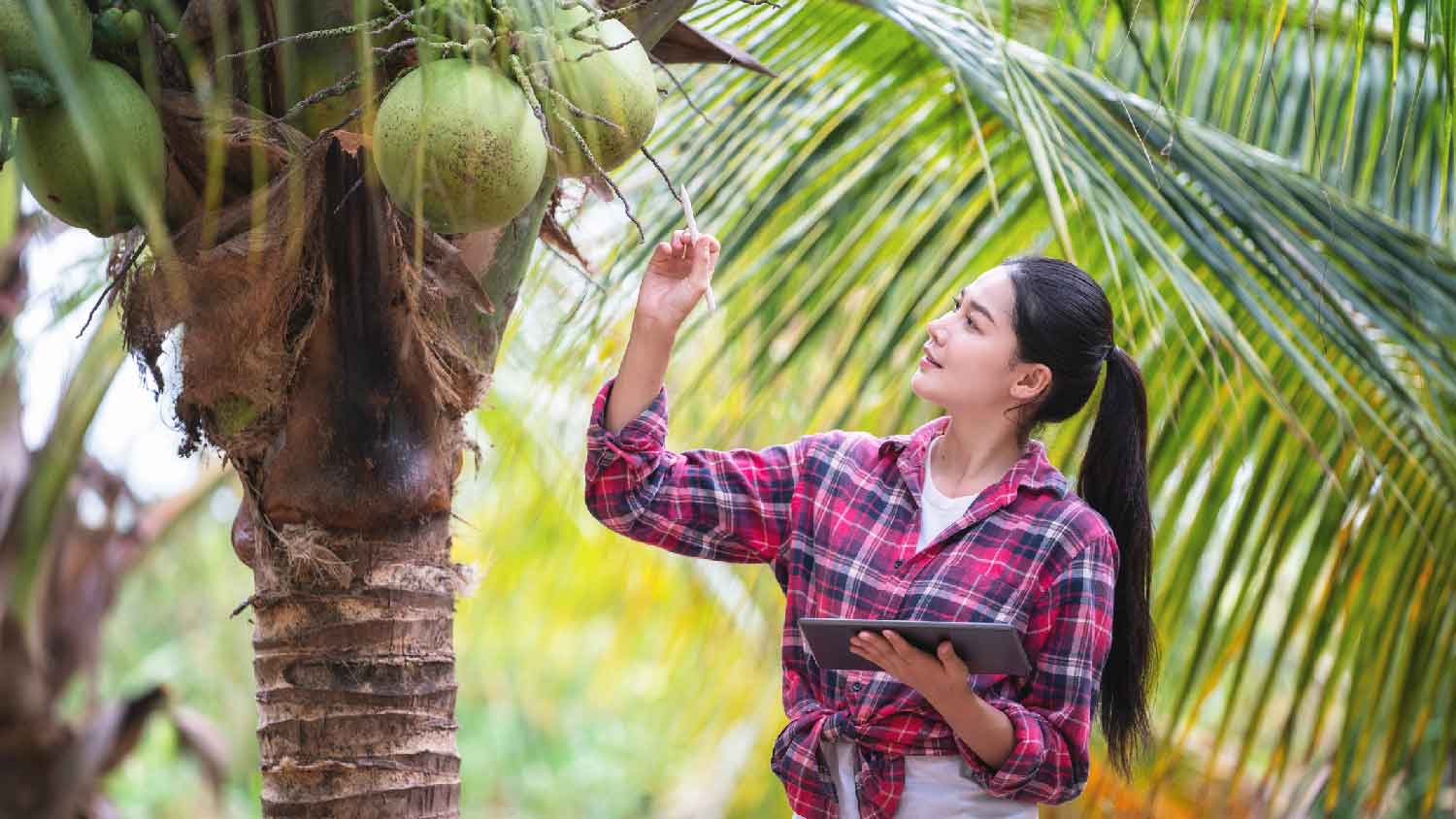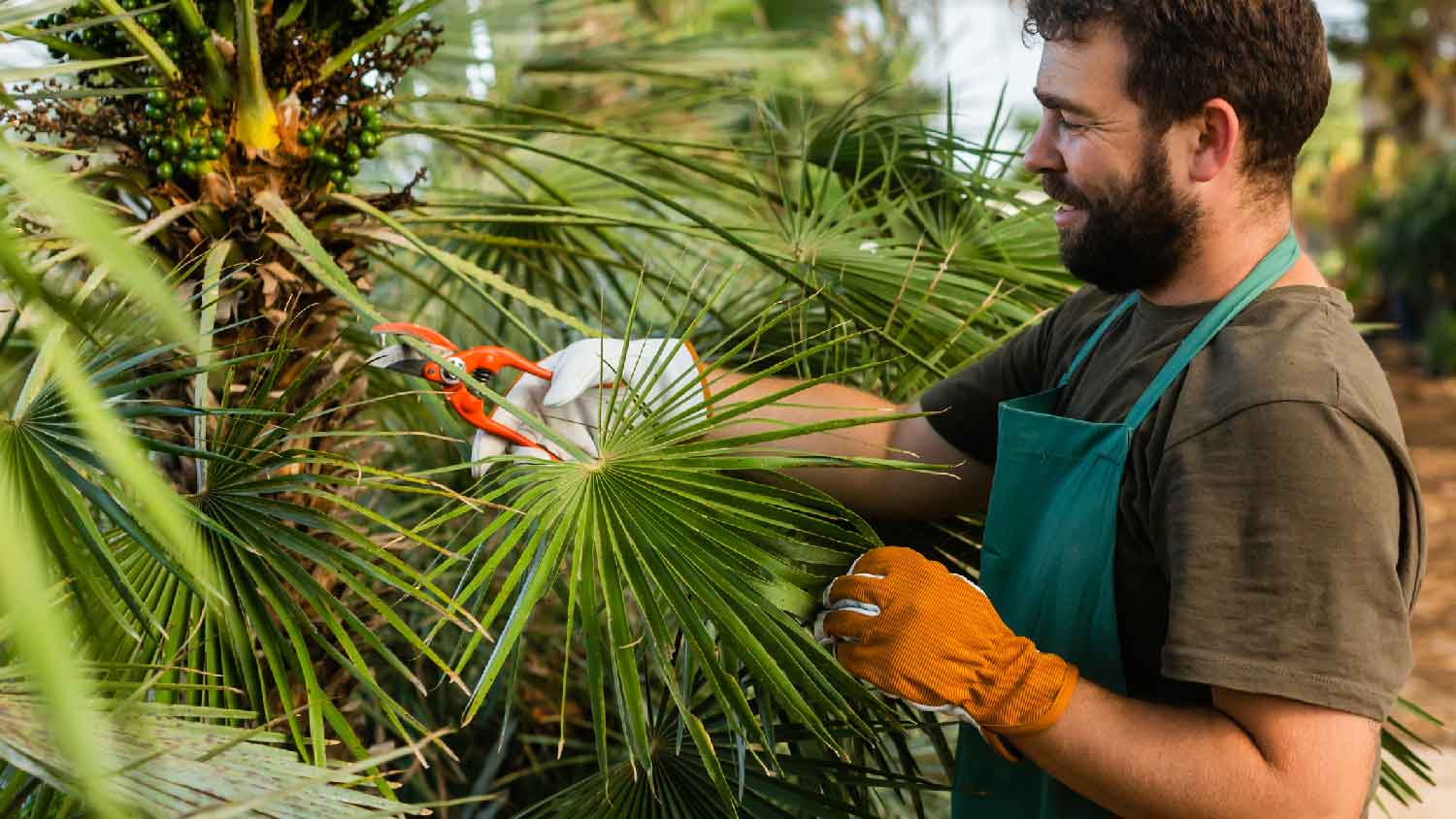Get transparent shrub removal cost info. Learn average prices, key cost factors, and tips to save on your next shrub removal project.
What To Do With a Dead Palm Tree: 4 Options to Consider
Revive or remove your dead palm tree in a few simple steps


Dead or dying palm trees can collapse or attract pests, but a palm tree pro can remove unstable trunks safely.
Removing tall palms requires lifts, cranes, or bucket trucks to prevent injury or property damage.
Palm tree removal costs $650 to $1,500 on average, depending on size and access.
If you notice that the once vibrant and bright palm tree fronds are brittle and brown or yellow, your palm tree might be dying or dead. So, what do you do with a dead palm tree?
Palm trees die or become sick for many reasons, including a lack of nutrients, too much or too little sunlight, and pruning during the wrong season—to name a few. Luckily, our guide will show you what to do with a dead palm tree.

How to Know if Your Palm Tree is Dead

The first step in figuring out how to proceed with your dead palm tree is to make sure it’s officially dead. You might want to hire an arborist or a palm tree specialist to come out and inspect your palm tree, and you can expect to pay an average of $860 for the visit.
Here are the signs that your palm tree is no longer living:
Inspect the fronds: If the fronds are brittle, dry, and brown or yellow, there’s a good chance the palm tree is dead.
Check for disease: When the tree is alive, it may be infected with pests. However, if the tree has died, pests typically move on to new trees for fresh nutrients.
Look for growth: Check the crown of the palm tree for fresh, new fronds. If there aren’t any new fronds, your palm tree might have died.
What to Do With a Dead Palm Tree
If you suspect your palm tree might be dead or dying, it’s important to address the problem immediately and find solutions to save or remove the tree. Otherwise, you may end up with the following issues:
Dead palm trees can fall and injure pedestrians or damage property.
Diseased palms can spread to other plants and trees in your garden.
A dead palm’s root system can continue to grow and cause structural damage to your home and the sidewalk, as well as water, sewer, and electrical lines.
There are several ways you can try to revive a dead palm tree. However, if the palm tree has died, you’ll need to remove it safely. Below, we’ll discuss the options you can take to bring your palm tree back to life.
1. Add New Fertilizer
Palm trees need essential nutrients like calcium, iron, potassium, and magnesium to survive. Without the proper nutrients, your palm tree can become sick and die. That’s why choosing a high-quality fertilizer with slow-release features is essential to ensure the nutrients won’t get washed away during rain storms. Make sure to re-fertilize your palm tree three times per year for maximum nutrient buildup.
2. Remove Dead Fronds
If you notice browning fronds, don’t panic and start cutting them down—that can cause the palm to lose nutrients and prevent new fronds from growing. Instead, wait until the fronds are brown, yellow, and brittle, and carefully cut them down.
3. Provide the Right Amount of Water
Palm trees can die either by watering them too much or too little. You’ll want to water your palm trees more in the summer to prevent the leaves from drying out. Water them less in the winter to prevent the fronds from turning yellow or green and eventually falling off. You can purchase a soil meter to ensure you’re providing your palm with the correct amount of water.
4. Remove the Palm Tree
If you’ve tried to revive the palm tree without success, you’ll need to remove the palm tree safely. It’s best to have trees removed by a professional palm tree removal company. Felling trees is extremely dangerous and can cause severe injuries and major property damage if the job is done incorrectly. So, if you don’t have experience cutting down trees, and if the tree is over 12 feet tall, then it’s best to leave it to the pros.
Here are a couple of different ways palm trees are removed:
Remove With Ropes
Assess the area surrounding the palm tree to ensure there’s enough room for the tree to fall.
Anchor the tree down with ropes on all sides at least 2 feet away from the tree.
Estimate extra distance around the tree for the palm’s root ball—which grows outwards from the tree's base.
Take a shovel and dig inwards towards the tree’s roots until the root ball is exposed.
Start cutting the exposed roots with a pruning shear if you can’t see the root ball clearly.
Slowly lower the tree to the ground with one of the ropes.
Cut the Tree Down
If the tree cannot safely fall, a pro will need to cut the palm into small chunks before removing it. Always use safety gear, and do not attempt to cut a large tree down if you don’t have previous experience.
Assess the area to ensure it’s safe for the tree to fall.
Get a chainsaw. Depending on the size of the palm tree, you may also need to use a crane to physically pull the palm out of the ground.
Wear a safety harness and trim the fronds and branches with pruning shears—again, if the tree is very tall, you’ll need to use a bucket truck to lift yourself up.
Make a notch in the tree’s base using an axe.
Take the chainsaw and slice through the tree diagonally—cut 1/4 of the way through the tree.
Go to the tree's opposite side and cut through the rest of it with the chainsaw.
As soon as the tree starts to fall, make sure you remain on the opposite side.
Professional Removal
On average, you can expect your palm tree removal cost to run between $650 and $1,500. Your price will depend on several factors, including the palm tree's size, condition, accessibility, and whether it qualifies as emergency tree removal. You might also need to factor in additional costs, such as cleanup and debris removal, permits, and heavy machinery upcharges.
Why Do I Have a Dead Palm Tree?
Your palm tree might be dead for many reasons, including:
Lack of proper care
Cutting fronds off too early
Lack of water
Low-quality soil or fertilizer
Too much or too little sunlight
Feeding the palm the wrong nutrients
Pruning during the hurricane season
Planting palms at the incorrect depth
Fertilizer burning the palm tree roots
How to Prevent a Palm Tree From Dying

Regularly caring for your palm tree is an excellent step to keep it from dying. Here are several ways to prevent a palm tree from dying:
When planting a new palm tree, use high-quality soil that will provide the proper drainage.
Plant new palms out of intense sunlight and shade—too much sun can burn the palm tree, whereas too little sun can turn palm fronds brown.
Plant new palms only deep enough to cover the root ball.
Trim your palm tree annually, costing $100 to $1,500 per tree.
Do not prune your palm tree during hurricane season. Palms need fronds to protect them from harsh winds.
Look for signs of palm tree diseases and treat them immediately.
Place fertilizer at least two feet away from the palm’s roots. Otherwise, the fertilizer can burn the roots, making the palm susceptible to disease and pest infestation.
DIY vs. Hiring a Pro
While you can take the proper steps to revive a dead or dying palm tree, we recommend hiring a palm tree expert near you to tackle removing a palm tree. Pros have the knowledge, equipment, experience, tools, and supplies to do the job correctly and efficiently. Not only that, but a fully licensed and insured palm tree pro will be able to obtain the necessary permits for dead palm tree removal.
The homeowners guide to tree services
From average costs to expert advice, get all the answers you need to get your job done.
- •

Discover the average tree maintenance cost, key price factors, and tips to save. Get expert insights to plan your tree care budget with confidence.

Tree inspections can ensure your trees stay healthy and safe, preventing costly damage. Learn how much tree inspections cost and what can affect the price.

Bamboo has a habit of spreading through root growth. Here’s how to stop bamboo roots in its tracks with the most effective methods, and tips on what doesn’t work.

Tree stumps can be unsightly trip hazards, but they can also have a new life. Learn how to hollow out a tree stump to repurpose it into a planter.

Burning a stump is a DIY stump removal option that is low-cost and effective in certain scenarios. Learn how to burn a stump safely and effectively.

